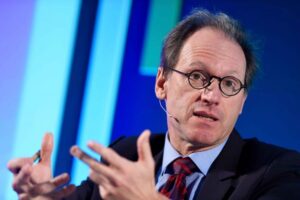
Asia-Pacific, Civil Society, Climate Change Finance, Climate Change Justice, COP29, Development & Aid, Editors’ Choice, Environment, Featured, Global, Headlines, Human Rights, Humanitarian Emergencies, Sustainable Development Goals, TerraViva United Nations, Women in Politics

Romina Khurshid Alam, the Coordinator to the Prime Minister of Pakistan on Climate Change at the Pakistan Pavilion at the COP29 Venue in Baku. Credit: Umar Manzoor Shah/IPS
– Romina Khurshid Alam, the Coordinator to the Prime Minister of Pakistan on Climate Change, praised the resilience of the people of her country in the face of climate disasters and has put her faith into diplomacy to achieve climate justice.
Speaking to IPS against the backdrop of a rising environmental crisis and unfulfilled promises by developed nations, Alam outlined the necessity of climate diplomacy as a tool to bridge global disparities and address the collective challenges posed by climate change.
Climate Diplomacy: A Global Imperative
Alam said that climate diplomacy is of utmost importance in a world where disasters transcend borders.
“Climate diplomacy is crucial because the challenges we face today are not confined to one nation,” she said. “Smog, floods, and melting glaciers do not ask for permission to cross boundaries. Even the largest wars have been resolved through dialogue, and we must adopt the same approach for climate issues.”
Recalling the devastating floods in Pakistan in 2022, Alam said the human and economic toll the country has faced was massive. Vulnerable nations like Pakistan, she argued, are bearing the brunt of a crisis they did little to create.
“We are paying the price for a problem caused by others. Despite our minimal contributions to global emissions, we are expected to ‘do more’ while developed countries delay fulfilling their commitments.”

A flooded village in Matiari, in the Sindh province of Pakistan. Credit: UNICEF/Asad Zaidi
Unkept Promises and the Loss and Damage Fund
Alam expressed frustration with the slow progress of the Loss and Damage Fund, a financial mechanism agreed to in previous COPs to support vulnerable nations.
“What happened to those pledges? Where is the funding? Promises are made at every COP, but they rarely materialize into action,” she said, while urging developed nations to stop making new commitments until they have fulfilled their existing ones and also stressing that accountability and transparency are essential.
Alam also criticized the lack of accessibility to promised funds for developing nations.
“It’s not just about pledging money—it’s about ensuring those funds reach the countries that need them. Mechanisms must be simplified so that nations like Pakistan can access what is rightfully theirs.”
Education and Climate Justice
During the interview, Alam drew attention to the intersection of climate change and education.
“Children in Pakistan are losing their right to education because of environmental crises like smog and floods,” she said. “How can we expect to provide green education when children can’t even make it to school safely?”
Alam called for climate justice that includes the protection of basic human rights, such as education, for the next generation.
She also pointed to the reluctance of neighboring countries to engage in meaningful discussions on shared challenges. “Regional solutions are imperative. Disasters don’t respect political or geographical boundaries, and neither should our response to them.”
International Climate Justice Court
Alam also shared her vision of an International Climate Justice Court, where vulnerable nations can hold major polluters accountable.
“I have requested the establishment of an International Climate Justice Court to protect the rights of those most affected by climate change,” she said. “Pakistan has already taken the lead by engaging national and international judges in this effort. Justice Mansoor Ali Shah has been instrumental in highlighting the need for such a court.”
According to Alam, this court could empower vulnerable nations to seek redress and enforce accountability, especially for unfulfilled commitments by developed countries.
“Why should children in Pakistan or other vulnerable nations suffer because of decisions made elsewhere? It’s time we demand answers.”
Human Rights and Climate Change
For Alam, the climate crisis is not just an environmental issue but also a severe human rights violation.
“Developed nations often champion human rights, but they fail to recognize the rights being violated in vulnerable countries due to climate change,” she said. “The loss of lives, homes, and livelihoods in countries like Pakistan is a direct result of inaction by wealthier nations.”
She called on the international community to view the climate crisis through a humanitarian lens. “This is about humanity. The sun shines on all, and disasters strike indiscriminately. We must come together, regardless of our differences, to address this shared challenge.”
Pakistan’s Role as a Climate Advocate
Alam praised the resilience of the Pakistani people, particularly in the aftermath of the 2022 floods.
“Our people have shown incredible strength,” she said. “Even the poorest woman who loses her roof to a flood will rebuild her life with courage. This resilience is what keeps us moving forward.”
She also highlighted Pakistan’s leadership in raising the voices of vulnerable nations. “Pakistan doesn’t just speak for itself; we speak for all developing countries that are facing the consequences of climate change. Peace and cooperation are essential, and Pakistan will continue to advocate for both.”
IPS UN Bureau Report










